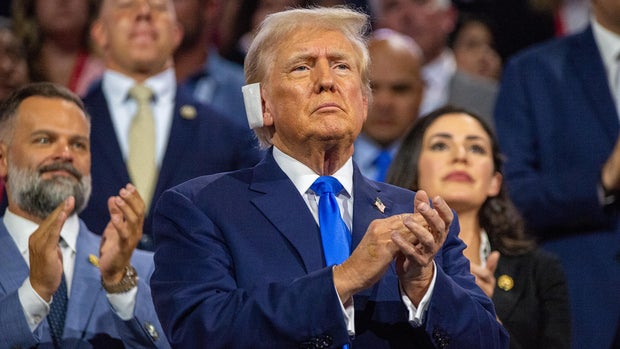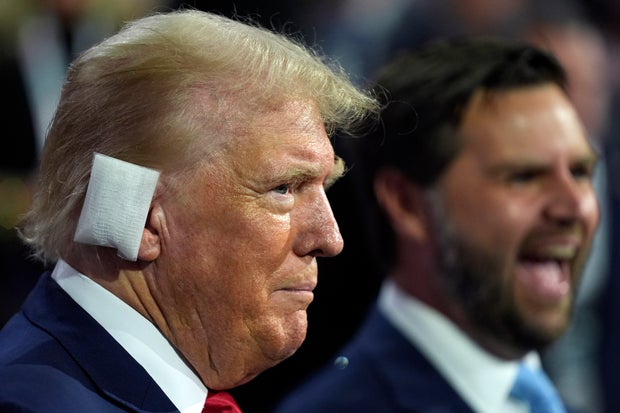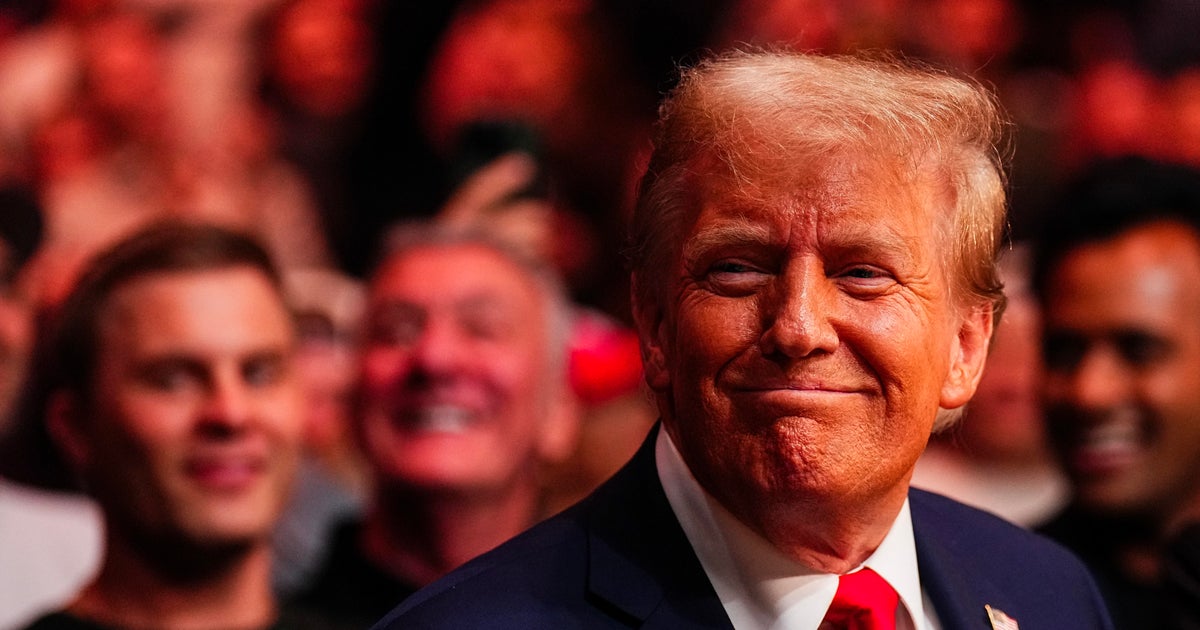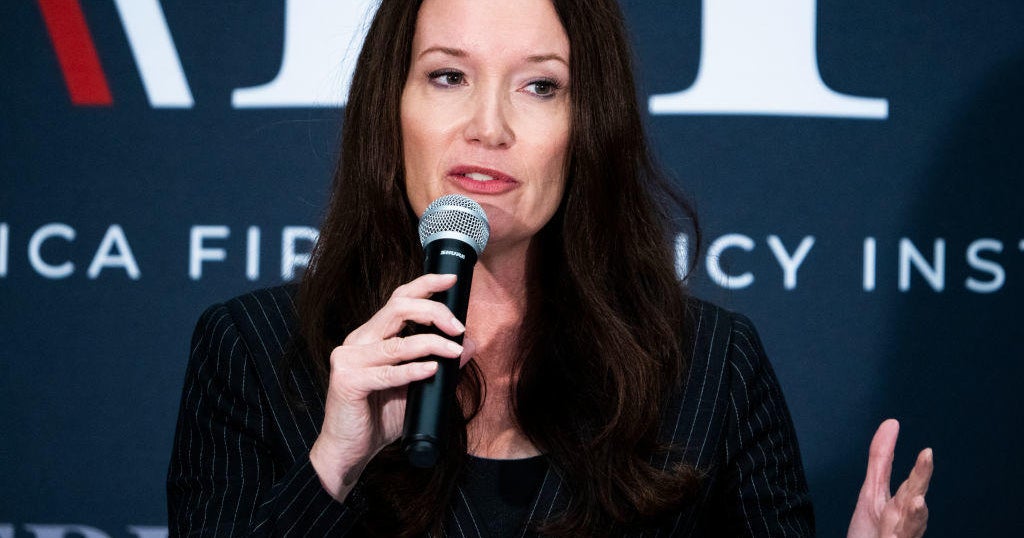CBS News
Donald Trump doesn’t have stitches after assassination attempt, but a “nice flesh wound,” Eric Trump says

Former President Donald Trump’s son, Eric Trump, said his father doesn’t have stitches after he was shot in an assassination attempt at a rally in Pennsylvania over the weekend, but that he has a “nice flesh wound” from the shooting.
The former president could be seen touching his ear as the attack unfolded, before he was shielded by Secret Service and whisked off the rally stage with blood on his face. When he appeared at the Republican National Convention on Monday and Tuesday, he wore a large bandage over his injury.
Speaking to “CBS Mornings” co-host Tony Dokoupil from the convention in Milwaukee Wednesday morning, Eric Trump said his father has referred to the injury as “the greatest earache he’s ever had.”
“You know, he was millimeters away from having his life expunged … I’m sure the ear doesn’t feel well,” Eric Trump said.
Eric Trump also told “CBS Evening News” anchor and managing editor Norah O’Donnell on Tuesday that his father’s hearing is fine and that he is “in great spirits.”
Jacek Boczarski/Anadolu via Getty Images
The former president was addressing supporters in Butler, Pennsylvania, on Saturday when a 20-year-old gunman, Thomas Matthew Crooks, opened fire — killing a spectator and injuring Trump and two others.
Trump said in a social media post later that night that a bullet “pierced” the upper part of his right ear.
“I knew immediately that something was wrong in that I heard a whizzing sound, shots, and immediately felt the bullet ripping through the skin,” he said. “Much bleeding took place, so I realized then what was happening.”
Rep. Ronny Jackson, who was Donald Trump’s White House doctor, told The New York Times that “the bullet took a little bit off the top of his ear in an area that, just by nature, bleeds like crazy.”
Jackson replaced the former president’s ear dressing during a flight to the Republican convention on Sunday, the Times reported.
“The dressing’s bulked up a bit because you need a bit of absorbent,” he said. “You don’t want to be walking around with bloody gauze on his ear.”
Evan Vucci/AP
Some Republican convention attendees have worn ear bandages as a show of support for the former president.
“This is the newest fashion trend. I’m getting this going,” Joe Neglia, a delegate from Tempe, Arizona, told CBS News’ Ed O’Keefe on Tuesday evening. “Everybody in the world’s going to be wearing these pretty soon. It’s the latest thing. My wife tells me I dress like an engineer, but I’m setting new fashion ground here.”
CBS News
A study to devise nutritional guidance just for you

It’s been said the best meals come from the heart, not from a recipe book. But at this USDA kitchen, there’s no pinch of this, dash of that, no dollops or smidgens of anything. Here, nutritionists in white coats painstakingly measure every single ingredient, down to the tenth of a gram.
Sheryn Stover is expected to eat every crumb of her pizza; any tiny morsels she does miss go back to the kitchen, where they’re scrutinized like evidence of some dietary crime.
Stover (or participant #8180, as she’s known) is one of some 10,000 volunteers enrolled in a $170 million nutrition study run by the National Institutes of Health. “At 78, not many people get to do studies that are going to affect a great amount of people, and I thought this was a great opportunity to do that,” she said.
CBS News
It’s called the Nutrition for Precision Health Study. “When I tell people about the study, the reaction usually is, ‘Oh, that’s so cool, can I do it?'” said coordinator Holly Nicastro.
She explained just what “precise” precisely means: “Precision nutrition means tailoring nutrition or dietary guidance to the individual.”
The government has long offered guidelines to help us eat better. In the 1940s we had the “Basic 7.” In the ’50s, the “Basic 4.” We’ve had the “Food Wheel,” the “Food Pyramid,” and currently, “My Plate.”
CBS News
They’re all well-intentioned, except they’re all based on averages – what works best for most people, most of the time. But according to Nicastro, there is no one best way to eat. “We know from virtually every nutrition study ever conducted, we have inner individual variability,” she said. “That means we have some people that are going to respond, and some people that aren’t. There’s no one-size-fits-all.”
The study’s participants, like Stover, are all being drawn from another NIH study program called All Of Us, a massive undertaking to create a database of at least a million people who are volunteering everything from their electronic health records to their DNA. It was from that All of Us research that Stover discovered she has the gene that makes some foods taste bitter, which could explain why she ate more of one kind of food than another.
Professor Sai Das, who oversees the study at Tufts University, says the goal of precision nutrition is to drill down even deeper into those individual differences. “We’re moving away from just saying everybody go do this, to being able to say, ‘Okay, if you have X, Y and Z characteristics, then you’re more likely to respond to a diet, and somebody else that has A, B and C characteristics will be responding to the diet differently,'” Das said.
It’s a big commitment for Stover, who is one of 150 people being paid to live at a handful of test sites around the country for six weeks – two weeks at a time. It’s so precise she can’t even go for a walk without a dietary chaperone. “Well, you could stop and buy candy … God forbid, you can’t do that!” she laughed.
While she’s here, everything from her resting metabolic rate, her body fat percentage, her bone mineral content, even the microbes in her gut (digested by a machine that essentially is a smart toilet paper reading device) are being analyzed for how hers may differ from someone else’s.
Nicastro said, “We really think that what’s going on in your poop is going to tell us a lot of information about your health and how you respond to food.”
CBS News
Stover says she doesn’t mind, except for the odd sounds the machine makes. While she is a live-in participant, thousands of others are participating from their homes, where electronic wearables track all kinds of health data, including special glasses that record everything they eat, activated when someone starts chewing. Artificial intelligence can then be used to determine not only which foods the person is eating, but how many calories are consumed.
This study is expected to be wrapped up by 2027, and because of it, we may indeed know not only to eat more fruits and vegetables, but what combination of foods is really best for us. The question that even Holly Nicastro can’t answer is, will we listen? “You can lead a horse to water; you can’t make them drink,” she said. “We can tailor the interventions all day. But one hypothesis I have is that if the guidance is tailored to the individual, it’s going to make that individual more likely to follow it, because this is for me, this was designed for me.”
For more info:
Story produced by Mark Hudspeth. Editor: Ed Givnish.
“Sunday Morning” 2024 “Food Issue” recipe index
Delicious menu suggestions from top chefs, cookbook authors, food writers, restaurateurs, and the editors of Food & Wine magazine.
CBS News
A new generation of shopping cart, with GPS and AI

Watch CBS News
Be the first to know
Get browser notifications for breaking news, live events, and exclusive reporting.
CBS News
“All hands on deck” for Idaho’s annual potato harvest

Watch CBS News
Be the first to know
Get browser notifications for breaking news, live events, and exclusive reporting.













